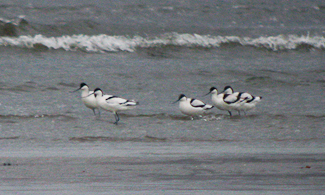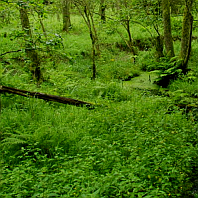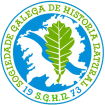Fragas do Mandeo was quite busy this fall participating in several forums that promote land stewardship. We also spent a lot of time negotiating custody agreements. The groundwork has been done and we hope that results will soon follow. Nevertheless, we still find time to visit the Betanzos estuary to watch birds on migration, which stop in our region to rest and feed.
On Sunday we saw a species never before seen in the estuary: the avocet (Recurvirostra avosetta). This beautiful bird is easily identifiable since, apart from its vivid black and white colours, has an upcurved beak, which makes it unmistakable.
 The Southeast gale promised some surprises, since strong winds always bring with them some unusual species. This is what happened with the flock of avocets that were on Fiobre’s Beach (Bergondo). There were three adults and two juveniles. Standing on the shore and facing the wind to keep the air from ruffling their feathers. From time to time they were disturbed by a Sandwich tern (Sterna sandvicensis). Some grey plovers (Pluvialis squatarola), were also nearby, a couple of great black-backed gulls (Larus marinus), a flock of twelve turnstones (Arenaria interpres) and another of twenty eight pintails (Anas acuta), an unusually large number for the estuary.
The Southeast gale promised some surprises, since strong winds always bring with them some unusual species. This is what happened with the flock of avocets that were on Fiobre’s Beach (Bergondo). There were three adults and two juveniles. Standing on the shore and facing the wind to keep the air from ruffling their feathers. From time to time they were disturbed by a Sandwich tern (Sterna sandvicensis). Some grey plovers (Pluvialis squatarola), were also nearby, a couple of great black-backed gulls (Larus marinus), a flock of twelve turnstones (Arenaria interpres) and another of twenty eight pintails (Anas acuta), an unusually large number for the estuary.
The avocets will soon continue their journey towards the South of the peninsula, or they may even cross to Africa. They breed in wetland areas elsewhere in Spain, but not in Galicia. This small flock probably comes from one of their breeding sites in the South of England, from the French coast, the Netherlands or even from Southern Sweden. The form of its characteristic beak helps them catch their prey, because they feed on aquatic invertebrates, sweeping the bottom in shallow water with their beak.
The more we know our estuary the more we realize its importance for migratory birds. It is just one of the many wetland areas of the Galician coast, a place to feed and temporarily find shelter on their way to Southern lands. We have to work for the preservation of this chain of spaces vital for so many migratory aquatic species.



















